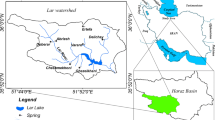Abstract
Kazan Trona ore field, the second discovered deposit in Central Turkey, is planned to be extracted by solution mining technology. Understanding the hydrogeology of the springs in such an area is vital since they can be affected during mining operations. The aim of this study is to provide an isotopic approach by utilizing environmental isotope techniques to the springs in the study area, thereby, to enhance the understanding of their occurrence by complementing the previous geochemical studies. Here, the isotopic signatures and the recharge elevations of the springs are demonstrated together with their field parameters. The relationship between δD and δ18O suggest strong evaporation in some of the samples after recharge. For those springs, the unmodified signatures were determined and the recharge elevations were calculated to be between 1100 and 1248 m. These elevations correspond to Incirlik and Asmalidere Members and upper Neogene units. The relationship between Tritium and Electrical Conductivity suggested that SP-6, SP-3 and SP-4 have shallow circulation when compared to SP-7 having both the lowest tritium and highest EC value. This finding is in accordance with the geochemical data, which suggests SP-7 emerges from the deeper, older groundwater present above the trona deposit.
Similar content being viewed by others
References
Apaydin, A. (2004) Study of recharge and conditions of Cakiloba-Karadoruk aquifer system (western Beypazari-Ankara). PhD Thesis, Hacettepe University, Ankara, 147p.
Arslan, S. (2008) Investigation of the recharge and discharge mechanisms of a complex aquifer system by using environmental isotopes and noble gases. PhD Thesis, Middle East Technical University, Ankara, 180p.
ASTM (1999) Standard Test Methods for Low-Level Dissolved Oxygen in Water, D5543-94, ASTM International, West Conshohocken, PA.
Camur, M.Z., Er, C. and Yazicigil, H. (2008) Modeling of lithology induced chemical anomalies in the aquifer systems of the Kazan Trona deposit area, Ankara, Turkey. Environ. Geol., v.54(4), pp.777–789.
Clark, I. and Fritz, P. (1997) Environmental Isotopes in Hydrogeology. CRC Press, Boca Raton, 352p.
Clarke, W.B., Jenkins, W.J. and Top, Z. (1976) Determination of tritium by mass-spectrometric measurement of He-3. International Journal of Applied Radiation and Isotopes, v27(9), pp.515–522.
Craig, H. (1961) Isotopic variations in meteoric waters, Science, v.133, pp.1702–1703.
Drimmie, R.J., Shouakar-stash, O., Walters, R. and Heemskerk, A.R. (2001) Hydrogen isotope ratio by automatic, continuous flow, elemental analyses, and isotope ratio mass spectrometry, University of Waterloo, Ontario, Canada.
Epstein, S. and Mayeda, T. (1953) Variation of O-18 content of waters from natural sources. Geochimica Cosmochimica Acta 4(5), pp.213–224.
Gilbert, T.W., Behymer, T.D. and Castaneda, H.B. (1982) Determination of dissolved-oxygen in natural and wastewaters. American Laboratory, v.14(3), 119p.
IAEA/ WMO (2004) Global Network of Isotopes in Precipitation. The GNIP Database.
Ludin, A., Weppernig, R., Boenisch, G. and Schlosser, P. (1997) Mass spectrometric measurement of helium isotopes and tritium, Lamont-Doherty Earth Observatory, New York.
Rojay, B., Toprak, V. and Bozkurt, E. (2002) Core sample analysis in Kazan Soda Project Area, Middle East Technical University, Ankara.
Rozanski, K., Araguas-araguas, L. and Gonfiantini, R. (1993) Isotopic Patterns in Modern Global Precipitation. In: P.K. Swart, K.C. Lohmann, J. McKenzie, and S. Savin (Eds.), Climate Change in Continental Isotopic Records. Geophysical Monograph 78, Amer. Geophys. Union, pp.1–36.
SRK (2001) Hydrogeology, Conceptual Understanding, Kazan Trona Project Ankara, Turkey.
SRK (2004) Hydrogeological Modeling Kazan Trona Project, Ankara, Turkey.
Toprak, V. and Rojay, B. (2000) Geology Baseline Study for the Kazan Soda Project Area, Ankara, Turkey, Middle East Technical University.
Toprak, V. and Rojay, B. (2001) Geological Investigation in Kazan Soda Project Area, Ankara, Turkey, Middle East Technical University.
Yazicigil, H., Doyuran, V., & Ccamur, M.Z., Duru, U., Sakiyan, J., Yilmaz, K.K., Toprak, F.Ö. and Pusatli, T. (2001) Hydrogeology-Hydrogeochemistry Baseline Study of the Kazan Trona Project Area, Ankara, Turkey, Middle East Technical University, Project No: 00-0309-02-00-08, 355p.
Yazicigil, H., Er, C., Ates, J.S. and Camur, M.Z. (2009) Effects of solution mining on groundwater quality in the Kazan trona field, Ankara-Turkey: model predictions. Environ. Geol., v57(1), pp.157–172.
Author information
Authors and Affiliations
Corresponding author
Rights and permissions
About this article
Cite this article
Arslan, S., Yazicigil, H. Environmental isotopic evaluation of the springs located in Kazan Trona basin in Central Turkey. J Geol Soc India 80, 707–714 (2012). https://doi.org/10.1007/s12594-012-0196-7
Received:
Accepted:
Published:
Issue Date:
DOI: https://doi.org/10.1007/s12594-012-0196-7




